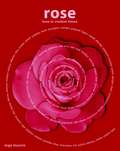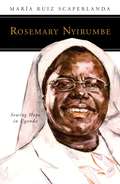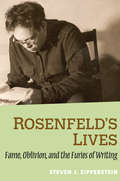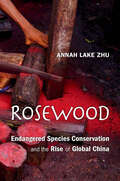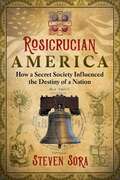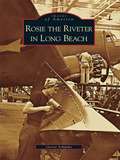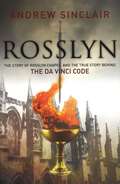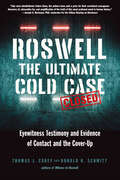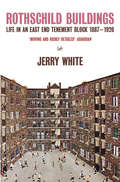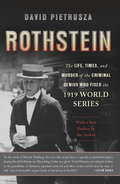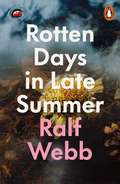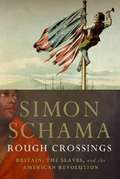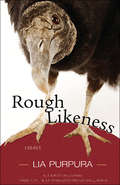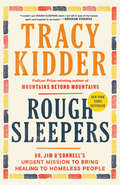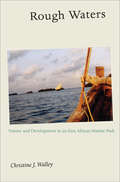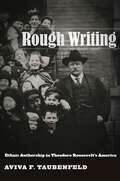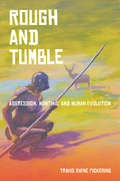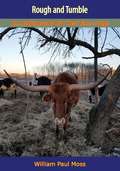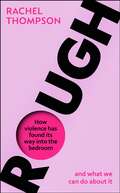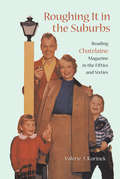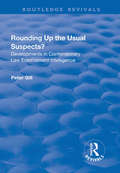- Table View
- List View
Rose: Love in Violent Times
by Inga MuscioWith trademark precision and razor-sharp wit, Inga Muscio explores the impacts of passive violence, abuse, war, and cultural trauma on our most intimate lives in order to uncover a path toward healthy and imaginative sex and love.Rose breaks new ground in answering a fundamental question in most feminist and antiracist writing: how do we identify, witness, and then recover from trauma--as individuals, as families, as communities, and as a country? Muscio's ability to address dire topics with a unique freshness and bravery allows her readers to confront the true brutality of a violent culture, then to react powerfully with righteous rage and hopeful determination.Chilling, eye-opening, and thoroughly enjoyable, Rose offers a fresh and exhilarating perspective on achieving empowerment and self-possession.
Rosemary Nyirumbe: Sewing Hope in Uganda (People of God)
by Maria Ruiz ScaperlandaSister Nyirumbe's 62 years of life provide a powerful testament to God’s presence, love, and hope amidst unimaginable violence. Throughout these many years, her native Uganda and southern Sudan (now South Sudan) have suffered the devastating effects of war and military clashes. Children, as the most vulnerable population, have suffered the most—being orphaned, kidnapped, forced to become child soldiers and sex-slaves. In Rosemary Nyirumbe: Sewing Hope in Uganda, María Ruiz Scaperlanda brings to light Sister Rosemary’s vocation of loving presence to these youth in the midst of this cultural and societal obliteration. As a Sister of the Sacred Heart of Jesus for over 45 years, Sister Rosemary, even at great risk to herself, continues to minister to children enduring the violence around them, teaching practical skills, while helping them to heal, forgive, and hope. Her work taking in girls escaping captivity by Joseph Kony and his Lord’s Resistance Army (LRA) has earned her international recognition. She has been named one of TIME magazine’s "100 Most Influential People in the World."
Rosenfeld's Lives: Fame, Oblivion, and the Furies of Writing
by Steven J. ZippersteinBorn in Chicago in 1918, the prodigiously gifted and erudite Isaac Rosenfeld was anointed a "genius" upon the publication of his "luminescent" novel, Passage from Home and was expected to surpass even his closest friend and rival, Saul Bellow. Yet when felled by a heart attack at the age of thirty-eight, Rosenfeld had published relatively little, his life reduced to a metaphor for literary failure. In this deeply contemplative book, Steven J. Zipperstein seeks to reclaim Rosenfeld's legacy by "opening up" his work. Zipperstein examines for the first time the "small mountain" of unfinished manuscripts the writer left behind, as well as his fiercely candid journals and letters. In the process, Zipperstein unearths a turbulent life that was obsessively grounded in a profound commitment to the ideals of the writing life. Rosenfeld's Lives is a fascinating exploration of literary genius and aspiration and the paradoxical power of literature to elevate and to enslave. It illuminates the cultural and political tensions of post-war America, Jewish intellectual life of the era, and--most poignantly--the struggle at the heart of any writer's life.
Rosewood: Endangered Species Conservation and the Rise of Global China
by Annah Lake ZhuA riveting study of the booming rosewood trade between China and Madagascar uncovers an alternative approach to environmentalism that disrupts Western models. Rosewood is the world’s most trafficked endangered species by value, accounting for larger outlays than ivory, rhino horn, and big cats put together. Nearly all rosewood logs are sent to China, fueling a $26 billion market for classically styled furniture. Vast expeditions across Asia and Africa search for the majestic timber, and legions of Chinese ships sail for Madagascar, where rosewood is purchased straight from the forest. The international response has been to interdict the trade, but in this incisive account Annah Lake Zhu suggests that environmentalists have misunderstood both the intent and the effect of China’s appetite for rosewood, causing social and ecological damage in the process. For one thing, Chinese consumers are understandably seeking to reclaim their cultural heritage, restoring a centuries-old tradition of home furnishing that the Cultural Revolution had condemned. In addition, Chinese firms are investing in environmental preservation. Far from simply exploiting the tree, businesses are carefully managing valuable forests and experimenting with extensive new plantings. This sustainable-use paradigm differs dramatically from the conservation norms preferred by Western-dominated NGOs, whose trade bans have prompted speculation and high prices, even encouraging criminal activity. Meanwhile, attempts to arm conservation task forces—militias meant to guard the forests—have backfired. Drawing on years of fieldwork in China and Madagascar, Rosewood upends the pieties of the global aid industry. Zhu offers a rigorous look at what environmentalism and biodiversity protection might look like in a world no longer dominated by the West.
Rosicrucian America: How a Secret Society Influenced the Destiny of a Nation
by Steven SoraAn in-depth history of Rosicrucianism, its key members, and their roles in the formation and settling of America • Explores Sir Francis Bacon and Dr. John Dee&’s deep influence on England&’s colonization of America as well as the Rosicrucian influence on the Founding Fathers and on cities such as Philadelphia and Williamsburg • Explains how Bacon was the author of many anonymous Rosicrucian texts and how he envisioned America as the &“New Atlantis&” • Reveals the connections of the Order of the Rosy Cross to the Knights of the Golden Circle and to the Georgia Guidestones Dr. John Dee and his polymath protégé Sir Francis Bacon were the most influential men in the court of Queen Elizabeth I, part of an elite group with invisible control throughout Europe. And, as Steven Sora reveals, not only were they key members of the Rosicrucians, they were the driving force behind England&’s colonization of the New World and the eventual establishment of the United States. From Avalon in Newfoundland to New England to Pennsylvania and Virginia, Sora shows how Bacon and Dee&’s Rosicrucian impact is felt throughout North America. He details Bacon&’s possible authorship of the anonymous Rosicrucian texts of the early 1600s, his connections with Sir Walter Raleigh&’s School of Night, and the origins of Rosicrucianism in Bacon&’s Order of the Helmet. He explains how Bacon envisioned America as the New Atlantis, a utopia where liberty and freedom of learning prevailed--a key tenet of the &“Invisible College&” of the Rosicrucian Order--and how Dee convinced the Queen that England had rightful claims in the New World by drawing on legends of both King Arthur and Welsh Prince Madoc voyaging West to America. Sora looks at Rosicrucian influences on the Founding Fathers and earliest settlers of America, such as Washington, Franklin, and William Penn of Pennsylvania, on the American Revolution, and on American colonies, such as the Williamsburg colony. He details how Penn invited Rosicrucians to Philadelphia and how the city&’s layout follows esoteric principles, including a direct reference to Bacon&’s New Atlantis. Moving into the 1800s and beyond, he reveals how a handful of Rosicrucians served as the Inner Sanctum of the Knights of the Golden Circle and how Rosicrucians are behind the Georgia Guidestones, carved granite monoliths with messages in ancient languages. Providing a thorough and expansive view of Rosicrucianism, its occult origins, and its deep imprint on America, Sora shows how this secret society still continues to exert invisible influence on the modern world.
Rosie the Riveter in Long Beach (Images of America)
by Gerrie SchipskeDuring World War II, an unprecedented number of womentook jobs at aircraft plants, shipyards, munitions factories, and other concerns across the nation to produce material essential to winning the war. Affectionately and collectively called "Rosie the Riveter" after a popular 1943 song, thousands of these women came to the U.S. Army-financed Douglas Aircraft Plant in Long Beach, the largest wartime plane manufacturer, to help produce an astonishing number of the aircraft used in the war. They riveted,welded, assembled, and installed, doing man-sized jobs, making attack bombers, other war birds, and cargo transports. They trained at Long Beach City Schools and worked 8- and 10-hour shifts in a windowless, bomb-proof plant. Their children attended Long Beach Day Nursery, and their households ran on rations and victory gardens. When the men came home after the war ended, most of these resilient women lost their jobs.
Rosslyn: The Story of the Rosslyn Chapel and the True Story Behind the Da Vinci Code
by Andrew SinclairThe mysterious history of Rosslyn Chapel and the Knights Templar is revealed in this authoritative volume by a descendent of its first patrons. In the 15th century, William Sinclair, 1st Earl of Caithness and Baron of Roslin, built a Catholic chapel in the Midlothian region of Scotland. Famous for its esoteric symbolism, this flamboyant Gothic church was of great importance to the Knights Templar, who formed a third Temple of Solomon with the patronage of the Sinclair lairds. Historian Andrew Sinclair, whose own family lineage traces back to William, explores the rise and fall of Rosslyn over the course of centuries. It is a tale of religious conflicts and ancient relics, of epic battles and secret societies. Along the way, he dispels the many myths and misinterpretations that have grown up around Rosslyn, as the fortunes of the Sinclair family declined and the Church and Castle fell into ruin.
Roswell: The Ultimate Cold Case
by Thomas J. Carey Donald R. Schmitt“[The authors] have, like each whistleblower before them, paid a price for their . . . amplification of the truth. . . . The most profound event in human history.” —Joseph G. Buchman, Ph.D, moderator for the Citizen Hearing on DisclosureTwo of the world’s leading investigators declare definitively that the Roswell Incident happened and present their closing arguments.For more than seventy years, the crash at Roswell and its ensuing controversies and cover-ups have been investigated. Yet despite continually mounting evidence, there are still disbelievers. Roswell: The Ultimate Cold Case is Carey and Schmitt’s final and commanding word on the case in which they declare victory once and for all.The government has changed their official story on Roswell more than a dozen times, but the witnesses have not recanted. The evidence has not gone away. And won’t go away. The Roswell Incident is the most hotly debated and investigated UFO crash in history with seemingly endless evidence, and eyewitnesses coming forward even years later. Finally, late in life people feel safe enough or feel duty bound to reveal what they know, saw, and heard.Roswell: The Ultimate Cold Case will bring all new exclusive eye witness testimonies to light as well as cover the:Connection of astronauts Edgar Mitchell and Neil Armstrong to Roswell.Connection of Clinton, Carter, Goldwater, Schiff, and Richardson to Roswell.First time artist conception of impact site with craft and bodies based on firsthand testimony.First time full-size model of crash survivor based on eyewitness testimony.And more eyewitness corroboration.“There is no one on this planet who knows more about the Roswell incident than these two guys.” —Larry Landsman, director of special projects for the Syfy Channel
Rothschild Buildings: Life in an East-End Tenement Block 1887 - 1920
by Jerry WhiteWinner of the Jewish Chronicle Harold H. Wingate Literary Award.Rothschild Buildings were typical of the 'model dwellings for the working classes' which were such an important part of the response to late-Victorian London's housing problem. They were built for poor but respectable Jewish immigrants from Eastern Europe, and the community which put down roots there was to be characteristic of the East End Jewish working class in its formative years. By talking to people who grew up in the Buildings in the 1890s and after, and using untapped documentary evidence from a wide range of public and private sources, the author re-creates the richly detailed life of that community and its relations with the economy and culture around it. The book shows how cramped and austere housing was made into homes; how the mechanism of class domination, of which the Buildings were part, was both accepted and fought against; how a close community was riven with constantly shifting tensions; and how that community co-existed in surprising ways with the East End casual poor of 'outcast London'. It provides unique and fascinating insights into immigrant and working-class life at the turn of the last century.
Rothstein: The Life, Times, and Murder of the Criminal Genius Who Fixed the 1919 World Series
by David PietruszaHistory remembers Arnold Rothstein as the man who fixed the 1919 World Series, an underworld genius. The real-life model for The Great Gatsby's Meyer Wolfsheim and Nathan Detroit from Guys and Dolls, Rothstein was much more--and less--than a fixer of baseball games. He was everything that made 1920s Manhattan roar. Featuring Jazz Age Broadway with its thugs, speakeasies, showgirls, political movers and shakers, and stars of the Golden Age of Sports, this is a biography of the man who dominated an age. Arnold Rothstein was a loan shark, pool shark, bookmaker, thief, fence of stolen property, political fixer, Wall Street swindler, labor racketeer, rumrunner, and mastermind of the modern drug trade. Among his monikers were "The Big Bankroll," "The Brain," and "The Man Uptown. " This vivid account of Rothstein's life is also the story of con artists, crooked cops, politicians, gang lords, newsmen, speakeasy owners, gamblers and the like. Finally unraveling the mystery of Rothstein's November 1928 murder in a Times Square hotel room, David Pietrusza has cemented The Big Bankroll's place among the most influential and fascinating legendary American criminals.
Rotten Days in Late Summer
by Ralf WebbA TELEGRAPH AND IRISH TIMES BOOK OF THE YEARLONGLISTED FOR THE POLARI FIRST BOOK PRIZE SHORTLISTED FOR THE FORWARD PRIZE FOR BEST FIRST COLLECTIONSHORTLISTED FOR THE JOHN POLLARD FOUNDATION INTERNATIONAL POETRY PRIZE 'Impressive . . . tender, unflinching' Guardian'This is poetry in the grand tradition of annihiliation by desire. It's what the young are always learning, and the old, if they are wise, never forget' Anne Boyer, author of The Undying'Brilliant . . . heralds the arrival of a frank and vital poetic voice' Sharlene Teo, author of Ponti'Frank and alert . . . an important voice in British poetry' Eley Williams, author of The Liar's Dictionary'Direct and heart-breaking' Alex Dimitrov, author of Love and Other Poems'A rare thing . . . razor-sharp' Julia Copus, author of This Rare Spirit: A Life of Charlotte MewIn Rotten Days in Late Summer, Ralf Webb turns poetry to an examination of the textures of class, youth, adulthood and death in the working communities of the West Country, from mobile home parks, boyish factory workers and saleswomen kept on the road for days at a time, to the yearnings of young love and the complexities of masculinity.Alongside individual poems, three sequences predominate: a series of 'Love Stories', charting a course through the dreams, lies and salt-baked limbs of multiple relationships; 'Diagnostics', which tells the story of the death from cancer of the poet's father; and 'Treetops', a virtuosic long poem weaving together grief and mental health struggles in an attempt to come to terms with the overwhelming data of a life.The world of these poems is close, dangerous, lustrous and difficult: a world in which whole existences are lived in the spin of almost-inescapable fates. In searching for the light within it, this prodigious debut collection announces the arrival of a major new voice in British poetry.
Rotten to the Core?: The Life and Death of Neville Heath (Routledge Revivals)
by Francis SelwynThe Second World War created heroes and scoundrels in good measure. Few men shifted from role to role with the insolent ease of Neville Heath. Exchanging one alias for another, he was at various times Lord ‘Jimmy’ Dudley, Captain Bruce Lockhart, ‘The Cambridge Blue’, Group-Captain Rupert Brooke, and Lieutenant-Colonel James Rupert Cadogan Armstrong, DFC, AFC. In reality Neville Heath was the product of public school and Borstal, an officer and a gentleman dismissed by three armed services and four times convicted in the civilian courts. His final conviction in 1946 was for the most notorious murder of the post-war world.Originally published in 1988, Rotten to the Core? asks who was the real Neville Heath? As Francis Selwyn describes him, the masks he adopted corresponded to a distorted truth. He had been a pilot on active service, but his deeds of heroism were accomplished by log-book forgeries. Yet he was a daredevil, a driver of fast and stolen cars, a would-be cat-burglar, apparently impervious to fear. He lived on the edge of discovery and disgrace, as if exhilarated by the tension. But the escapism of the daydreamer and pilot was allied to a deep inner corruption. With some women who fell for his matinée-idol good looks and debonair charm, he was the perfect gentleman. To some he proved a cold-hearted swindler. With others, he was a sadist who delighted in causing pain. His moral aberration drove him to murder. Neville Heath ended his life on the gallows, playing the officer and gentleman to the last.Francis Selwyn’s tense and vividly written book was a fine successor to Hitler’s Englishman, his biography of William Joyce (Lord Haw-Haw), another misfit from the pre-war world. Rotten to the Core? deals with Heath the psychopath, but it also depicts the curious post-war society which allowed him to take root and to flourish, showing that Heath the confidence trickster – and murderer – was a man of his time.
Rough Crossings: Britain, the Slaves and the American Revolution
by Simon SchamaFor Schama, the neglect of African American experiences -- at the time of the American Revolution -- is particularly regretful because within the fires of that conflict one can locate an important episode in the struggle for black freedom. He describes how African-American slaves by the thousands responded to the British offer of emancipation by escaping from their plantations and making the arduous journey northward to Canada. He also describes how authorities on both sides of the war responded to this phenomenon as they struggled to gain advantage in the war.
Rough Likeness: Essays
by Lia PurpuraLia Purpura's essays are full of joy in the act of intense observation; they're also deliciously subversive and alert to the ways language gets locked and loaded by culture. These elegant, conversational excursions refuse to let a reader slide over anything, from the tiniest shards of beach glass to barren big-box wastelands. They detonate distractedness, superficiality, artificiality. In the process, Purpura inhabits many stances: metaphysician and biologist, sensualist and witness-all in service of illuminating that which Virginia Woolf called "moments of being"-previously unworded but palpably felt states of existence and knowing. Rough Likeness finds worlds in the minute, and crafts monuments to beauty and strangeness.
Rough Metaphysics: The Speculative Thought and Mediumship of Jane Roberts
by Peter SkafishA powerful case for why anthropology should study outsiders of thought and their speculative ideas What sort of thinking is needed to study anomalies in thought? In this trenchantly argued and beautifully written book, anthropologist Peter Skafish explores this provocative question by examining the writings of the medium and &“rough metaphysician&” Jane Roberts (1929–1984). Through a close interpretation of her own published texts as well as those she understood herself to have dictated for her cohort of channeled personalities—including one, named &“Seth,&” who would inspire the New Age movement—Skafish shows her intuitive and dreamlike work to be a source of rigorously inventive ideas about science, ontology, translation, and pluralism. Arguing that Roberts&’s writings contain philosophies ahead of their time, he also asks: How might our understanding of speculative thinking change if we consider the way untrained writers, occult visionaries, and their counterparts in other cultural traditions undertake it? What can outsider thinkers teach us about the limitations of even our most critical intellectual habits?Rough Metaphysics is at once an ethnography of the books of a strange and yet remarkable writer, a commentary on the unlikely philosophy contained in them, and a call for a new way of doing (and undoing) philosophy through anthropology, and vice versa. In guiding the reader through Roberts&’s often hallucinatory &“world of concepts,&” Skafish also develops a series of original interpretations of thinkers—from William James to Claude Lévi-Strauss to Paul Feyerabend—who have been vital to anthropologists and their fellow travelers.Seductively written and surprising in its turns of thought, Rough Metaphysics is a feast for anyone who wants to learn how to think something new, especially about thought.
Rough Sleepers: Dr. Jim O'Connell's Urgent Mission to Bring Healing to Homeless People
by Tracy KidderThe powerful story of an inspiring doctor who made a difference, by helping to create a program to care for Boston’s homeless community—by the Pulitzer Prize–winning, New York Times bestselling author of Mountains Beyond Mountains. <p><p> In Rough Sleepers, Kidder shows how one person can make a difference, as he tells the story of Dr. Jim O’Connell, a gifted man who invented ways to create a community of care for a city’s unhoused population, including those who sleep on the streets—the “rough sleepers.” When Jim O’Connell graduated from Harvard Medical School and was nearing the end of his residency at Massachusetts General Hospital, the chief of medicine made a proposal: Would he defer a prestigious fellowship and spend a year helping to create an organization to bring health care to homeless citizens? Jim took the job because he felt he couldn’t refuse. But that year turned into his life’s calling. <p><p>Tracy Kidder spent five years following Dr. O’Connell and his colleagues as they served their thousands of homeless patients. In this illuminating book we travel with O’Connell as he navigates the city, offering medical care, socks, soup, empathy, humor, and friendship to some of the city’s most endangered citizens. He emphasizes a style of medicine in which patients come first, joined with their providers in what he calls “a system of friends.” Much as he did with Paul Farmer in Mountains Beyond Mountains, Kidder explores how a small but dedicated group of people have changed countless lives by facing one of American society’s difficult problems instead of looking away. <p> <b>New York Times Bestseller</b>
Rough Waters: Nature and Development in an East African Marine Park
by Christine J. WalleyRough Waters explores one of the most crucial problems of the contemporary era--struggles over access to, and use of, the environment. It combines insights from anthropology, history, and environmental studies, mounting an interdisciplinary challenge to contemporary accounts of "globalization." The book focuses on The Mafia Island Marine Park, a national park in Tanzania that became the center of political conflict during its creation in the mid-1990s. The park, reflecting a new generation of internationally sponsored projects, was designed to encourage environmental conservation as well as development. Rather than excluding residents, as had been common in East Africa's mainland wildlife parks, Mafia Island was intended to represent a new type of national park that would encourage the participation of area residents and incorporate their ideas. While the park had been described in the project's general management plan as "for the people and by the people," residents remained excluded from the most basic decisions made about the park. The book details the day-to-day tensions and alliances that arose among Mafia residents, Tanzanian government officials, and representatives of international organizations, as each group attempted to control and define the park. Walley's analysis argues that a technocentric approach to conservation and development can work to the detriment of both poorer people and the environment. It further suggests that the concept of the global may be inadequate for understanding this and other social dramas in the contemporary world.
Rough Writing: Ethnic Authorship in Theodore Roosevelt’s America (Nation of Nations #6)
by Aviva F. TaubenfeldAs the United States struggled to absorb a massive influx of ethnically diverse immigrants at the turn of the twentieth century, the question of who and what an American is took on urgent intensity. It seemed more critical than ever to establish a definition by which Americanness could be established, transmitted, maintained, and judged. Americans of all stripes sought to articulate and enforce their visions of the nation’s past, present, and future; central to these attempts was President Theodore Roosevelt.Roosevelt fully recognized the narrative component of American identity, and he called upon authors of diverse European backgrounds including Israel Zangwill, Jacob Riis, Elizabeth Stern, and Finley Peter Dunne to promote the nation in popular written form. With the swell and shift in immigration, he realized that a more encompassing national literature was needed to “express and guide the soul of the nation.” Rough Writing examines the surprising place and implications of the immigrant and of ethnic writing in Roosevelt’s America and American literature.
Rough and Tumble: Aggression, Hunting, and Human Evolution
by Travis Rayne PickeringTravis Rayne Pickering argues that the advent of ambush hunting approximately two million years ago marked a milestone in human evolution, one that established the social dynamic that allowed our ancestors to expand their range and diet. He challenges the traditional link between aggression and human predation, however, claiming that while aggressive attack is a perfectly efficient way for our chimpanzee cousins to kill prey, it was a hopeless tactic for early human hunters, who--in comparison to their large, potentially dangerous prey--were small, weak, and slow-footed. Technology that evolved from wooden spears to stone-tipped spears and ultimately to the bow and arrow increased the distance between predator and prey and facilitated an emotional detachment that allowed hunters to stalk and kill large game. Based on studies of humans and of other primates, as well as on fossil and archaeological evidence, Rough and Tumble offers a new perspective on human evolution by decoupling ideas of aggression and predation to build a more realistic understanding of what it is to be human.
Rough and Tumble: An Autobiography of a West Texas Judge
by William Paul MossThis is the autobiography of West Texas judge William Paul Moss, which was first published in 1954, and predominantly explores his youthful adventures on his ranches in Texas and New Mexico, where he loved to raise cattle and hunt. Judge Moss describes his life as having consisted of three parts: cattle, law, and oil. In describing his job as a judge, he portrays himself as a conscientious lawyer and judge and proclaims his love for his adopted city and state, observing that “the judge passes upon all questions of law, subject to the right of appeal to the appellate courts.” His jurisdiction included both civil and criminal matters. Though not required by law he would appoint lawyers for those who could not afford them. Moss believed that a judge should try “to make his courthouse into a temple of justice” and he believed this involved keeping his mind “on the spirit of the law rather than its technicalities.” He observed: “A country judge is, in many respects, like a country lawyer. He has to know a little bit about everything. There are times when he may not even know much about the law.”
Rough: How violence has found its way into the bedroom and what we can do about it
by Rachel Thompson**AS HEARD ON BBC RADIO 4'S WOMEN'S HOUR**Rough is a revolutionary non-fiction work exploring the narratives of sexual violence that we don't talk about.A bad sexual experience.A grey area. Not rape but... A violation .These are the terms we use to describe the experiences we don't have words for. The way we talk about topics such as sex, consent, assault aren't fit for purpose.Through powerful testimony from 50 women and non-binary people, this book shines a light on the sexual violence that takes place in our bedrooms and beyond, sometimes at the hands of people we know, trust, or even love. Rough investigates violations such as 'stealthing,' non-consensual choking, and non-consensual rough sex acts that our culture is only starting to recognise as sexual violence.The book explores the ways in which systems of oppression manifest in our sexual culture - from racist microaggressions, to fatphobic acts of aggression, and ableist dehumanising behaviour. An intersectional, sex-positive, kink-positive work, the book also examines how white supremacy, transphobia, biphobia, homophobia, and misogyny are driving forces behind sexual violence.Rough is an urgent, timely call for change to the systems that oppress us all.'An incredible investigation into a frighteningly common part of our sexual experience,' Dr Fern Riddell'Rough speaks to how many women often feel after sexual encounters ...This book is excellent and demonstrates just how valid those feelings are,' Adele Walton, founder of Humanitarian Hotgirl
Rougher Justice
by Peter Squires Dawn StephenAnti-social behaviour has become a major political preoccupation of government and combating it is now a major plank of criminal justice policy. Yet anti-social behaviour as a concept has been little studied, and the notion has often been accepted uncritically. This book aims to meet this need, providing a critique of the government's use of the concept of anti-social behaviour and of youth justice strategy more generally. Rougher Justice foregrounds the perspectives and experiences of young people themselves. It draws upon recent developments within the field of cultural criminology to provide an alternative interpretation of the construction of 'youthful criminal careers'. It is underpinned by research in three separate areas which focus on the new youth justice, youthful criminal careers, and anti-social behaviour and acceptable behaviour enforcement. Central to the book is an ambition to understand youthful delinquency from the inside and to recover what is lost in much of New Labour's youth justice strategy --and the methods adopted by the Youth Justice Board to evaluate this strategy, that is to say a situated and interpretive understanding of youthful delinquency drawn from the perspective of and in the voices of young people themselves.
Roughing it in the Suburbs
by Valerie J. KorinekOriginally launched in 1928, by the 1950s and 1960s nearly two million readers every month sampled "Chatelaine" magazine's eclectic mixture of traditional and surprisingly unconventional articles and editorials. At a time when the American women's magazine market began to flounder thanks to the advent of television, "Chatelaine's" subscriptions expanded, as did the lively debate between its pages.Why?In this exhilarating study of Canada's foremost women's publication in the 50s and 60s, Valerie Korinek shows that while the magazine was certainly filled with advertisements that promoted domestic perfection through the endless expansion of consumer spending, a number of its sections - including fiction, features, letters, and the editor's column - began to contain material that subversively complicated the simple consumer recipes for affluent domesticity. Articles on abortion, spousal abuse, and poverty proliferated alongside explicitly feminist editorials. It was a potent mixture and the mail poured in - both praising and criticizing the new directions at the magazine.It was "Chatelaine's" highly interactive and participatory nature that encouraged what Korinek calls "a community of readers" - readers that in their very response to the magazine led to its success. "Chatelaine" did not cling to the stereotypical images of the era, instead it forged ahead providing women with a variety of images, ideas, and critiques of women's role in society. Chatelaine's dissemination of feminist ideas laid the foundation for feminism in Canada in the 1970s and after.Comprehensive, fascinating, and full of lively debate and history, "Roughing it in the Suburbs" provides a cultural study that weaves together a history of "Chatelaine's" producer's, consumers, and text. It illustrates how the structure of the magazine's production, and the composition of its editorial and business offices allowed for feminist material to infiltrate a mass-market women's monthly. In doing so it offers a detailed analysis of the times, the issues, and the national cross section of the women and, sometimes, men, who participated in the success of a Canadian cultural landmark.Winner of the Laura Jamieson Prize, awarded by the Canadian Research Institute for the Advancement of Women
Rounding Up the Usual Suspects?: Developments in Contemporary Law Enforcement Intelligence (Routledge Revivals)
by Peter GillThis title was first published in 2000: Policing is associated more with "doing" than with "thinking", so how can policing be "intelligent"? This text attempts to answer questions on police intelligence, and discusses whether or not policing can re-invent itself in the Information age. By using emerging technological tools is policing changing or is it just using them to control the "dangerous classes"? The development of "intelligence-led policing" seeks to shift organizational practices in order to attain goals more effectively. Charting and explaining the progress of this shift is a central aim of this study. The author compares the police intelligence structures of the UK with North America, especially Canada and New York State. The book looks at the contributions made, by the Government, the police and the criminals to the development of intelligence policing.
Rousseau in Drag
by Rosanne Terese KennedyThrough a series of close readings of most of Rousseau's major writings, this book provides a new interpretation of the eighteenth-century philosopher's sexual politics. The text argues that Rousseau's writings provide a critique of not only normative gender identity, but also normative familial and kinship relations.
